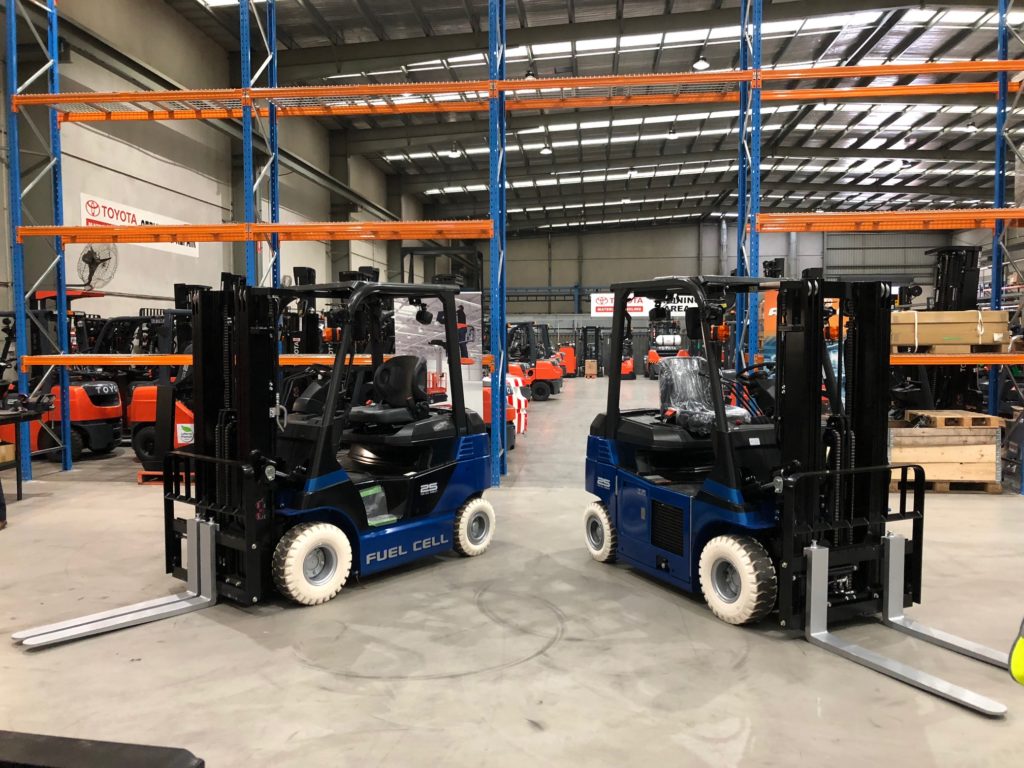
As electric forklifts continue to grow in popularity, manufacturers are making significant efforts to find ways to improve run-time and performance to match – or even exceed – their internal combustion (IC) engine counterparts.
Environmental concerns and availability of natural resources – such as coal, oil, and natural gas – are also driving the need to find a sustainable, long-term renewable energy solution.
Hydrogen is one viable alternative energy source. When it comes to material handling equipment or even automobiles and factories, hydrogen fuel cells have proven to be a realistic replacement for today’s conventional means of powering machinery and equipment.
At ProMat 2019, Toyota Material Handling unveiled a new 3-wheel fuel cell forklift that will go into production later this year. An ideal complement to the 4-wheel version unveiled at Toyota’s last ProMat appearance in 2009, the 3-wheel model continues Toyota’s promise to bring sustainable energy sources to the forefront of the material handling industry.
If you’re interested in what hydrogen can do for you and your business, here are some key insights into how fuel cells work, and how they can ultimately impact your bottom line.
READ MORE: Toyota Forklifts Leading the Hydrogen Charge
What is Hydrogen?
Hydrogen is a chemical element that can be found in natural resources like plants and water. While there is a finite amount of naturally-occurring hydrogen in the atmosphere, the element can be produced in alternative ways, including steam reforming, electrolysis, and gasification.
What is a Fuel Cell?
A fuel cell is a cell that produces an electric current as a direct result of a chemical reaction. The chemical reaction produces electricity that is used to power a load which, for our purposes, is a forklift. Fuel cells are used to power a wide range of products today, from small electronics to buses, and even certain industrial facilities.
How Does a Fuel Cell Forklift Work?
 Proton exchange membrane (PEM) fuel cells are currently the most viable type used for powering industrial equipment such as forklifts. Similar to a battery, PEM fuel cells utilize a cathode, anode, and an electrolyte to transfer electrons along an electrical path to power the forklift. Unlike a lead-acid battery, however, this process occurs using only hydrogen and oxygen found naturally in the atmosphere.
Proton exchange membrane (PEM) fuel cells are currently the most viable type used for powering industrial equipment such as forklifts. Similar to a battery, PEM fuel cells utilize a cathode, anode, and an electrolyte to transfer electrons along an electrical path to power the forklift. Unlike a lead-acid battery, however, this process occurs using only hydrogen and oxygen found naturally in the atmosphere.
The electrolyte, in this case, is a membrane that allows only positively charged ions to pass to the cathode, leaving negatively charged electrons to power the forklift. When the electrons, positively charged ions, and oxygen pulled in from the environment come together at the end of the circuit, it creates water as a byproduct that flows out of the fuel cell.
What are the Advantages of Fuel Cells in Material Handling?
Hydrogen-powered vehicles are similar to their IC engine counterparts in that they can be refilled quickly and easily at a fueling station. They also require less maintenance because they don’t need the watering, equalizing, charging, or cleaning that is required with lead-acid batteries.
While the bottom line is important to all businesses, it’s also important to consider the positive impact that fuel cells can have on the environment. With zero carbon emissions and potentially less reliance on natural resources to produce, fuel cells are a viable source of sustainable energy capable of powering more than just forklifts for the foreseeable future.

Read the most up to date Fuel Cell and Hydrogen Industry news at FuelCellsWorks




